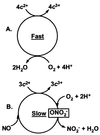Identification of a neuronal nitric oxide synthase in isolated cardiac mitochondria using electrochemical detection
- PMID: 11717466
- PMCID: PMC61179
- DOI: 10.1073/pnas.241380298
Identification of a neuronal nitric oxide synthase in isolated cardiac mitochondria using electrochemical detection
Abstract
Mitochondrial nitric oxide synthase (mtNOS), its cellular NOS isoform, and the effects of mitochondrially produced NO on bioenergetics have been controversial since mtNOS was first proposed in 1995. Here we functionally demonstrate the presence of a NOS in cardiac mitochondria. This was accomplished by direct porphyrinic microsensor measurement of Ca(2+)-dependent NO production in individual mitochondria isolated from wild-type mouse hearts. This NO production could be inhibited by NOS antagonists or protonophore collapse of the mitochondrial membrane potential. The similarity of mtNOS to the neuronal isoform was deduced by the absence of NO production in the mitochondria of knockout mice for the neuronal, but not the endothelial or inducible, isoforms. The effects of mitochondrially produced NO on bioenergetics were studied in intact cardiomyocytes isolated from dystrophin-deficient (mdx) mice. mdx cardiomyocytes are also deficient in cellular endothelial NOS, but overexpress mtNOS, which allowed us to study the mitochondrial enzyme in intact cells free of its cytosolic counterpart. In these cardiomyocytes, which produce NO beat-to-beat, inhibition of mtNOS increased myocyte shortening by approximately one-fourth. Beat-to-beat NO production and altered shortening by NOS inhibition were not observed in wild-type cells. A plausible mechanism for the reversible NO inhibition of contractility in these cells involves the reaction of NO with cytochrome c oxidase. This suggests a modulatory role for NO in oxidative phosphorylation and, in turn, myocardial contractility.
Figures







Similar articles
-
Differing roles of mitochondrial nitric oxide synthase in cardiomyocytes and urothelial cells.Am J Physiol Heart Circ Physiol. 2004 Jan;286(1):H13-21. doi: 10.1152/ajpheart.00737.2003. Am J Physiol Heart Circ Physiol. 2004. PMID: 14684357
-
The beneficial effects of melatonin against heart mitochondrial impairment during sepsis: inhibition of iNOS and preservation of nNOS.J Pineal Res. 2014 Jan;56(1):71-81. doi: 10.1111/jpi.12099. Epub 2013 Oct 21. J Pineal Res. 2014. PMID: 24117944
-
Melatonin counteracts inducible mitochondrial nitric oxide synthase-dependent mitochondrial dysfunction in skeletal muscle of septic mice.J Pineal Res. 2006 Jan;40(1):71-8. doi: 10.1111/j.1600-079X.2005.00281.x. J Pineal Res. 2006. PMID: 16313501
-
Mitochondrial nitric oxide synthase.Trends Pharmacol Sci. 2005 Apr;26(4):190-5. doi: 10.1016/j.tips.2005.02.005. Trends Pharmacol Sci. 2005. PMID: 15808343 Review.
-
Detection assays for determination of mitochondrial nitric oxide synthase activity; advantages and limitations.Methods Enzymol. 2008;440:317-34. doi: 10.1016/S0076-6879(07)00821-X. Methods Enzymol. 2008. PMID: 18423228 Review.
Cited by
-
Interaction between connexin 43 and nitric oxide synthase in mice heart mitochondria.J Cell Mol Med. 2015 Apr;19(4):815-25. doi: 10.1111/jcmm.12499. Epub 2015 Feb 9. J Cell Mol Med. 2015. PMID: 25678382 Free PMC article.
-
A novel method of measuring nitric-oxide-dependent fluorescence using 4,5-diaminofluorescein (DAF-2) in the isolated Langendorff-perfused rabbit heart.Pflugers Arch. 2008 Jun;456(3):635-45. doi: 10.1007/s00424-007-0440-y. Epub 2008 Jan 5. Pflugers Arch. 2008. PMID: 18180949
-
The opposite roles of nNOS in cardiac ischemia-reperfusion-induced injury and in ischemia preconditioning-induced cardioprotection in mice.J Physiol Sci. 2009 Jul;59(4):253-62. doi: 10.1007/s12576-009-0030-1. Epub 2009 Mar 4. J Physiol Sci. 2009. PMID: 19340535 Free PMC article.
-
Regulation of mitochondrial processes by protein S-nitrosylation.Biochim Biophys Acta. 2012 Jun;1820(6):712-21. doi: 10.1016/j.bbagen.2011.03.008. Epub 2011 Mar 21. Biochim Biophys Acta. 2012. PMID: 21397666 Free PMC article. Review.
-
Alcohol and mitochondria: a dysfunctional relationship.Gastroenterology. 2002 Jun;122(7):2049-63. doi: 10.1053/gast.2002.33613. Gastroenterology. 2002. PMID: 12055609 Free PMC article. Review.
References
-
- Kobzik L, Stringer B, Balligand J L, Reid M B, Stamler J S. Biochem Biophys Res Commun. 1995;211:375–381. - PubMed
-
- Bates T E, Loesch A, Burnstock G, Clark J B. Biochem Biophys Res Commun. 1995;213:896–900. - PubMed
-
- Bates T E, Loesch A, Burnstock G, Clark J B. Biochem Biophys Res Commun. 1996;218:40–44. - PubMed
-
- Ghafourifar P, Richter C. FEBS Lett. 1997;418:291–296. - PubMed
-
- Tatoyan A, Giulivi C. J Biol Chem. 1998;273:11044–11048. - PubMed
Publication types
MeSH terms
Substances
Grants and funding
LinkOut - more resources
Full Text Sources
Other Literature Sources
Molecular Biology Databases
Miscellaneous

